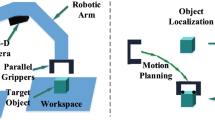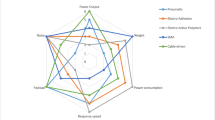Abstract
Improving the functionality of soft continuum manipulators to expand their application space has always been an important development direction for soft robotics. It remains very challenging to calculate the deformations of soft materials and predict the basic structure of soft fingers under complex objective functions and constraints. This work develops a cable-driven soft robotic gripper with multi-input and multi-output using topology optimization considering geometric nonlinearity, which not only performs adaptive grasping but also enables finer manipulations such as rotating or panning the target. A scheme that can describe adaptive grasping behavior is proposed, which converts the contact between the clamping surface and the object into a boundary condition to circumvent complex contact nonlinearities. An additive hyperelasticity technique is used to overcome numerical instabilities, and the finite element analysis is performed in ANSYS. Numerical simulations and experimental results are performed to demonstrate the effectiveness of the optimization algorithm and to illustrate the application potential of the proposed gripper.
















Similar content being viewed by others
References
Aage N, Andreassen E, Lazarov BS (2015) Topology optimization using petsc: an easy-to-use, fully parallel, open source topology optimization framework. Struct Multidiscip Optim 51(3):565–572
Aage N, Andreassen E, Lazarov BS, Sigmund O (2017) Giga-voxel computational morphogenesis for structural design. Nature 550(7674):84–86
Bendsøe MP, Kikuchi N (1988) Generating optimal topologies in structural design using a homogenization method. Comput Methods Appl Mech Eng 71(2):197–224
Chen F, Xu W, Zhang H, Wang Y, Cao J, Wang MY, Ren H, Zhu J, Zhang Y (2018) Topology optimized design, fabrication, and characterization of a soft cable-driven gripper. IEEE Robot Autom Lett 3(3):2463–2470
Chen Q, Zhang X, Zhu B (2019a) A 213-line topology optimization code for geometrically nonlinear structures. Struct Multidiscip Optim 59:1863–1879
Chen Q, Zhang X, Zhang H, Zhu B, Chen B (2019b) Topology optimization of bistable mechanisms with maximized differences between switching forces in forward and backward direction. Mech Mach Theory 139:131–143
Chen X (2016) Topology optimization of microfluidics—a review. Microchem J 127:52–61
Crooks W, Vukasin G, O’Sullivan M, Messner W, Rogers C (2016) Fin ray®; effect inspired soft robotic gripper: from the robosoft grand challenge toward optimization. Frontiers in Robotics and AI 3:70
De Leon DM, Alexandersen J, Fonseca JS, Sigmund O (2015) Stress-constrained topology optimization for compliant mechanism design. Struct Multidiscip Optim 52(5):929–943
Deaton JD, Grandhi RV (2014) A survey of structural and multidisciplinary continuum topology optimization: post 2000. Struct Multidiscip Optim 49(1):1–38
Deimel R, Brock O (2016) A novel type of compliant and underactuated robotic hand for dexterous grasping. Int J Robot Res 35(1-3):161–185
van Dijk NP, Maute K, Langelaar M, Van Keulen F (2013) Level-set methods for structural topology optimization: a review. Struct Multidiscip Optim 48(3):437–472
Dilgen CB, Dilgen SB, Aage N, Jensen JS (2019) Topology optimization of acoustic mechanical interaction problems: a comparative review. Struct Multidiscip Optim 60:779–801
Dühring MB, Jensen JS, Sigmund O (2008) Acoustic design by topology optimization. J Sound Vib 317(3-5):557–575
Fujii G, Takahashi M, Akimoto Y (2018) Cma-es-based structural topology optimization using a level set boundary expression—application to optical and carpet cloaks. Comput Methods Appl Mech Eng 332:624–643
George Thuruthel T, Ansari Y, Falotico E, Laschi C (2018) Control strategies for soft robotic manipulators: a survey. Soft Robot 5(2):149–163
Iguchi A, Tsuji Y, Yasui T, Hirayama K (2018) Topology optimal design for optical waveguides using time domain beam propagation method. IEICE Electronics Express 15(11):20180417–20180417
Ilievski F, Mazzeo AD, Shepherd RF, Chen X, Whitesides GM (2011) Soft robotics for chemists. Angew Chem Int Ed 50(8):1890–1895
Kalisky T, Wang Y, Shih B, Drotman D, Jadhav S, Aronoff-Spencer E, Tolley MT (2017) Differential pressure control of 3d printed soft fluidic actuators. In: 2017 IEEE/RSJ International Conference on Intelligent Robots and Systems (IROS). IEEE, Piscataway, pp 6207–6213
Kim S, Laschi C, Trimmer B (2013) Soft robotics: a bioinspired evolution in robotics. Trends Biotechnol 31(5):287–294
Laschi C, Mazzolai B, Cianchetti M (2016) Soft robotics: technologies and systems pushing the boundaries of robot abilities. Sci Robot 1(1):eaah3690
Li H, Zhu B, Zhang X, Wei J, Fatikow S (2020) Pose sensing and servo control of the compliant nanopositioners based on microscopic vision. IEEE Trans Ind Electron, pp. 1–1
Liu CH, Chen TL, Chiu CH, Hsu MC, Chen Y, Pai TY, Peng WG, Chiang YP (2018a) Optimal design of a soft robotic gripper for grasping unknown objects. Soft Robot 5(4):452–465
Liu CH, Huang GF, Chiu CH, Pai TY (2018b) Topology synthesis and optimal design of an adaptive compliant gripper to maximize output displacement. Journal of Intelligent & Robotic Systems, pp. 1–18
Liu H, Hu Y, Zhu B, Matusik W, Sifakis E (2018c) Narrow-band topology optimization on a sparsely populated grid. ACM Trans Graph (TOG) 37(6):1–14
Luo Y, Wang MY, Kang Z (2015) Topology optimization of geometrically nonlinear structures based on an additive hyperelasticity technique. Comput Methods Appl Mech Eng 286:422–441
Maghooa F, Stilli A, Noh Y, Althoefer K, Wurdemann HA (2015) Tendon and pressure actuation for a bio-inspired manipulator based on an antagonistic principle. In: 2015 IEEE International Conference on Robotics and Automation (ICRA). IEEE, Piscataway, pp 2556–2561
Manti M, Hassan T, Passetti G, D’Elia N, Laschi C, Cianchetti M (2015) A bioinspired soft robotic gripper for adaptable and effective grasping. Soft Robot 2(3):107–116
Marchese AD, Rus D (2016) Design, kinematics, and control of a soft spatial fluidic elastomer manipulator. Inte J Robot Res 35(7):840–869
Niiyama R, Sun X, Sung C, An B, Rus D, Kim S (2015) Pouch motors: printable soft actuators integrated with computational design. Soft Robot 2(2):59–70
Odhner LU, Jentoft LP, Claffee MR, Corson N, Tenzer Y, Ma RR, Buehler M, Kohout R, Howe D, Dollar AM (2014) A compliant, underactuated hand for robust manipulation. Inte J Robot Res 33 (5):736–752
Pedersen CB, Buhl T, Sigmund O (2001) Topology synthesis of large-displacement compliant mechanisms. Int J Numer Meth Eng 50(12):2683–2705
Peng X, Zhang N, Ge L, Gu G (2019) Dimension optimization of pneumatically actuated soft continuum manipulators. In: 2019 2nd IEEE international conference on soft robotics(RoboSoft). IEEE, Piscataway, pp 13–18
Petersson J, Borrvall T (2003) Topology optimization of fluids in stokes flow. Int J Numer Meth Fl 41:77–107
Petković D, D Pavlović N, Shamshirband S, Badrul Anuar N (2013) Development of a new type of passively adaptive compliant gripper. Industrial Robot: An International Journal 40(6):610– 623
Ranzani T, Cianchetti M, Gerboni G, De Falco I, Menciassi A (2016) A soft modular manipulator for minimally invasive surgery: design and characterization of a single module. IEEE Trans Robot 32(1):187–200
Renda F, Giorelli M, Calisti M, Cianchetti M, Laschi C (2014) Dynamic model of a multibending soft robot arm driven by cables. IEEE Trans Robot 30(5):1109–1122
Rus D, Tolley MT (2015) Design, fabrication and control of soft robots. Nature 521(7553):467
She Y, Chen J, Shi H, Su HJ (2016) Modeling and validation of a novel bending actuator for soft robotics applications. Soft Robot 3(2):71–81
Shian S, Bertoldi K, Clarke DR (2015) Dielectric elastomer based grippers for soft robotics. Adv Mater 27(43):6814–6819
Sigmund O (1997) On the design of compliant mechanisms using topology optimization. J Struct Mech 25 (4):493–524
Sigmund O (2001) Design of multiphysics actuators using topology optimization tress characteristics using tures. Copmput Methods Appl Mech Eng 190:6577–6604
Sigmund O, Maute K (2013) Topology optimization approaches. Struct Multidiscip Optim 48(6):1031–1055
Svanberg K (1987) The method of moving asymptotes—a new method for structural optimization. Int J Numer Meth Eng 24(2):359–373
Tran AV, Zhang X, Zhu B (2018) The development of a new piezoresistive pressure sensor for low pressures. IEEE Transactions on Industrial Electronics 65(8):6487–6496
Wang F (2018) Systematic design of 3d auxetic lattice materials with programmable poisson’s ratio for finite strains. J Mech Phys Solids 114:303–318
Wang F, Lazarov BS, Sigmund O (2011) On projection methods, convergence and robust formulations in topology optimization. Struct Multidiscip Optim 43(6):767–784
Wang F, Lazarov BS, Sigmund O, Jensen JS (2014) Interpolation scheme for fictitious domain techniques and topology optimization of finite strain elastic problems. Comput Methods Appl Mech Eng 276:453–472
Wang H, Wang C, Chen W, Liang X, Liu Y (2016) Three-dimensional dynamics for cable-driven soft manipulator. IEEE/ASME T Mech 22(1):18–28
Wang H, Zhang R, Chen W, Wang X, Pfeifer R (2017) A cable-driven soft robot surgical system for cardiothoracic endoscopic surgery: preclinical tests in animals. Surg Endosc 31(8):3152–3158
Wang R, Zhang X (2018) Parameters optimization and experiment of a planar parallel 3-dof nanopositioning system. IEEE Trans Ind Electron 65(3):2388–2397
Wang N, Guo H, Chen B, Cui C, Zhang X (2018) Design of a rotary dielectric elastomer actuator using a topology optimization method based on pairs of curves. Smart Mater Struct 27(5):055011
Wang N, Guo H, Chen B, Cui C, Zhang X (2019a) Integrated design of actuation and mechanism of dielectric elastomers using topology optimization based on fat bezier curves. Soft robotics 6(5):644–656
Wang R, Zhang X, Zhu B (2019b) Imposing minimum length scale in moving morphable component (mmc)-based topology optimization using an effective connection status (ecs) control method. Comput Meth Appl Mech Eng 351:667–693
Zhan Z, Zhang X, Zhang H, Chen G (2019) Unified motion reliability analysis and comparison study of planar parallel manipulators with interval joint clearance variables. Mech Mach Theory 138:58–75
Zhang X, Zhu B (2018) Topology optimization of distributed compliant mechanisms. In: Topology Optimization of Compliant Mechanisms. Springer, Berlin, pp 81–119
Zhang H, Kumar AS, Fuh JYH, Wang MY (2018a) Design and development of a topology-optimized three-dimensional printed soft gripper. Soft robotics 5(5):650–661
Zhang H, Kumar AS, Fuh JYH, Wang MY (2018b) Design and development of a topology-optimized three-dimensional printed soft gripper. Soft Robot 5(5):650–661
Zhang H, Zhu B, Zhang X (2019a) Origami kaleidocycle-inspired symmetric multistable compliant mechanisms. J Mech Robot 11(1):011009
Zhou M, Lazarov B S, Wang F, Sigmund O (2015) Minimum length scale in topology optimization by geometric constraints. Comput Methods Appl Mech Eng 293:266–282
Zhou J, Yi J, Chen X, Liu Z, Wang Z (2018) Bcl-13: a 13-dof soft robotic hand for dexterous grasping and in-hand manipulation. IEEE Robot Autom Lett 3(4):3379–3386
Zhu B, Zhang X, Fatikow S (2014) Level set-based topology optimization of hinge-free compliant mechanisms using a two-step elastic modeling method. J Mecha Design 136(3):031007
Zhu B, Chen Q, Li H, Zhang H, Zhang X (2019) Design of planar large-deflection compliant mechanisms with decoupled multi-input-output using topology optimization. J Mech Robot 11(3):031015
Zhu B, Zhang X, Zhang H, Liang J, Zang H, Li H, Wang R (2020) Design of compliant mechanisms using continuum topology optimization: a review. Mech Mach Theory 103622:143
Funding
This work was supported by the National Natural Science Foundation of China (Grant Nos. 51820105007, 51975216) and the Pearl River S&T Nova Program of Guangzhou (201906010061).
Author information
Authors and Affiliations
Corresponding authors
Ethics declarations
Conflict of interests
The authors declare that they have no conflict of interest.
Additional information
Responsible Editor: Somanath Nagendra
Publisher’s note
Springer Nature remains neutral with regard to jurisdictional claims in published maps and institutional affiliations.
Replication of results
All the necessary data to reproduce the results reported here are provided in Sections 4 and 5. Readers can also contact us to get the codes by Email:zhangxm@scut.edu.cn.
Rights and permissions
About this article
Cite this article
Wang, R., Zhang, X., Zhu, B. et al. Topology optimization of a cable-driven soft robotic gripper. Struct Multidisc Optim 62, 2749–2763 (2020). https://doi.org/10.1007/s00158-020-02619-y
Received:
Revised:
Accepted:
Published:
Issue Date:
DOI: https://doi.org/10.1007/s00158-020-02619-y




